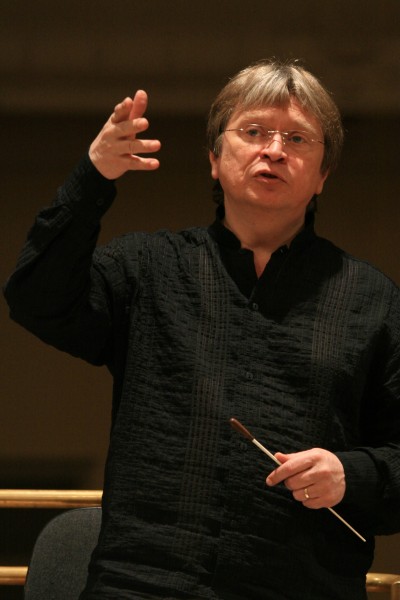St. Petersburg Philharmonic shows its velvet power at Carnegie

Nikolai Alexeev conducted the St. Petersburg Philharmonic Orchestra Friday night at Carnegie Hall. Photo: Meells Vind
The St. Petersburg Philharmonic played great symphonies by Russian composers in front of a sympathetic and enthusiastic crowd Friday night in Carnegie Hall. That audience was in some way the point and object of the concert.
The date, June 12, is Russia Day, the national holiday of the Russian Federation since 1992. An assertion of national pride, this year’s celebration has international components—the Carnegie Hall concert was one—that are inevitable quasi-propaganda events for the culture of a suddenly thriving Russian revanchism.
Not that there’s anything wrong with music as propaganda. All music is propaganda of some sort, putting the best points on a composer’s or musician’s personal values. Propaganda sent Dizzy Gillespie around the globe, and Sviatislov Richter to the West. And Friday, the sounds of the Tchaikovsky Symphony No. 4 and Shostakovich’s Symphony No. 5 made an easy- to-take argument for the importance of Russian musical culture.
The composers were beautifully served by a truly exceptional orchestra. The St. Petersburg Philharmonic has a gorgeous sound and they care about what they are playing. They were conducted by the orchestra’s deputy artistic director Nikolai Alexeev, who seemed unfussy, good natured, and completely dedicated to the music.
Alexeev shaped everything with as much legato as viable, and he allowed a notable amount of chaos to come through in the loudest and most active moments of each symphony. Both were done in a way that was not only appropriate but tremendously expressive.
The orchestra’s string tone, some of the most luscious around, grabbed the attention in their lilting entrance after the brass blasted out the mighty fate motif that opens Symphony No. 4. The section produces a velvet fog, as voluptuous and firm as both Mel Tormé and the dense marine layer that usually covers San Francisco.
The other sections are all superb, a reminder of how far orchestral playing has come in Russia since the end of the Cold War. Woodwinds played with excellent phrasing, and expression, and the brass section was both powerful and supple, producing an unexpected range of colors.
There was an uncanny and evocative quality to witnessing them play the Tchaikovsky Symphony. The performance was utterly great, and the straightforward interpretation and rich sound came across in the mind like hearing a great orchestral recording, spinning off an LP, on a late night radio broadcast. One analog wave of sound reinforced another, filling the night’s stillness in the imagination with warmth and companionship.
It was notable how in this impassioned symphony, the musicians played with lyricism, letting the music rise and full with an organic feeling. The audience responded with excited applause in between movements—which Alexeev seemed to find slightly embarrassing—and ecstasy at the end.
They did the same after a dolorous, plangent performance of the first movement of the Shostakovich, until the conductor made a “down, down” gesture with his hands—he wanted to keep each movement flowing into the next. This too was a powerful, haunting performance.
So many key features were played with exceptional care and meaning. The flute solo that begins the eerie coda of the first movement was fine enough, but the accompaniment was so controlled and subdued that it made the music spine-tingling. In the second movement, the orchestra emphasized the Mahlerian qualities, and the sustained lines in the third movement were breathtakingly delicate. As a whole, the ensemble captured one of the composer’s most distinctive orchestration ideas, making the whole orchestra sound like a giant strummed guitar.
The final movement was stunning, and troubling, as it should be. This was the piece that rehabilitated Shostakovich’s reputation after the political fiasco of Lady Macbeth of Mtensk, and the last section is triumphal. But the force of the minor chords and the turn away from settled, major resolution at the end have always made it clear that what triumphs is not goodness. Yet at the end, the response was a great roar from the crowd as people leapt to their feet. In that moment, the enigma of Shostokovich appeared clear—he made this piece to express the power of propaganda. That deserves playing as brilliant as this.
For the encore, it was the impish Shostakovich, a waltz from Act III of the musical Hypothetically Murdered. It’s a great little piece, both serious and subversive, poking fun at the form while loving it. It would have been ideal as the theme for Ernie Kovacs.







Posted Jun 19, 2015 at 6:14 pm by Gerald Risden
My wife and I were privileged to be in the audience for this performance . BRAVO hardly seems to be enough of a response. It was a magnificent concert from beginning to end. Carnegie Hall showed this orchestra off at its best.
Posted Jun 23, 2015 at 8:09 am by Lori Tripoli
Thanks for sharing the title of the encore–I would never have been able to find it!